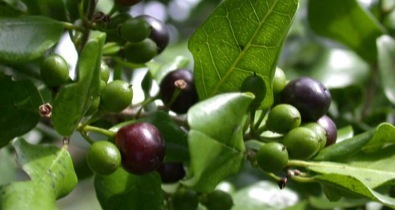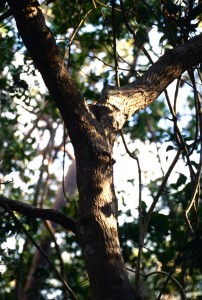Green twigs of Black Ironwood will sink in salt water. It’s that dense.
The Black Ironwood was once esteemed for its hard wood, some of the densest woods on earth at 1.42, on par with Lignum Vitae. It resists disease, termites and will outlast salt spray better than iron. For such a strong wood, though, hurricanes damage it, probably because it is so unyielding.
Dr. Daniel Austin, on whose scholarship I owe so much, said he took a class of undergraduates to a particular hammock for 31 years in a row and a trunk piece of blown-down Black Ironwood heartwood remain unchanged over the decades. His last undergraduate class and the authorities saw to it that Dr. Austin, retired, now has that piece of heartwood. It was Austin who noted the 50-some year old piece of wood far outlasted any piece of iron in the same environment.
In the Buckthorn family, Black Ironwood Is also called Leadwood because when it is cut the aroma given off is nearly identical to the smell of molten lead. Through the more rural Caribbean it is still used for tools and for making weapons, such as bows, arrows and lances. Because of its density it takes a high polish and is favored by turners. The sapwood is light brown, streaked, with the heartwood orange brown to dark brown. The fruit look similar to dark M&Ms.
The Black Ironwood is evergreen if it has plenty of water, though it can drop leaves in time of drought. By the way did you know in the tropics many trees don’t have visible growth rings because their moisture level is nearly even all year. Seasonal changes produce growth rings.
Botanically it is Krugiodendron ferreum (krug-ee-oh-DEN-dron krug-ee-oh-DEN-dron) Literally it means Krug’s Tree Iron. It was named for Carl Wilhelm Leopold Krug 1833-1898 German consul in Puerto RIco, businessman, botanist, science patron. Ferreum means iron and refers to the tree’s resistance.
Green Deane’s “Itemized” Plant Profile
IDENTIFICATION:
Shrub to small tree, 20 to 30 feet, with truck 10 inches thick, heaviest native wood in the United States, bark ridged, scaly. Leaves persist several years, opposite or alternate, ovate, may be notched at tip, deep-green, glossy above, pale below, to 2.5 inches long. Flowers late spring early summer, greenish, small clusters, fruits many, nearly round, 2/8 inch long, black, glossy, think skinned, juicy, sweet flesh, on single hard stone.
TIME OF YEAR:
September to November
ENVIRONMENT:
Hammocks, does not like salt water
METHOD OF PREPARATION:
Jam, jelly, wine, and raw out of hand. Not the greatest and not the worst.
HERB BLURB
The Maya used the bark and root decoction as a mouth was for toothache and gum issues. A decoction of the roots are purgative.



